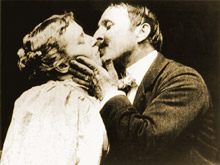William Heise
William Heise (born August 1847 in Germany; † February 14, 1910 ) was an American engineer and cameraman . Although he was involved in the development of the kinetoscope and the production of the first American films as a camera operator and director at the Edison Manufacturing Company from 1890 to 1898 , little biographical data are known about Heise.
Worked for Edison
William Heise was hired as a machinist at the Edison Laboratories in West Orange , New Jersey , in the fall of 1890 . He assisted William KL Dickson in the development and construction of the Kinetograph , an electrically operated film camera . In May 1891 Heise worked as operator of the first film recorded with this camera, the three-second film Dickson Greeting . To view the film, Dickson had developed the kinetoscope, a peep box in which the developed film strips were illuminated in an endless loop with an incandescent lamp and viewed through a magnifying glass.
After the camera had matured to such an extent through further changes in October 1892 that Edison was planning a commercial film production, Heise and Dickson stepped in front of the camera together to congratulate each other on their success ( A hand shake ). Images from this film were published in Phonogram magazine.
At the beginning of 1893 Dickson and Heise moved into a building specially built for film production, the Black Maria . The first film made in this studio, Blacksmith Scene , was shown at an Edison presentation to the Faculty of Physics at the Brooklyn Institute for Arts and Sciences in May 1893. After a few more experimental films, commercial film production began in early 1894. Dickson and Heise made around 75 films together in 1894, most of which showed circus and vaudeville artists or simple scenes from the world of work. B. Carmencita , a film about a dancer. Her films were sold in Kinetoscope salons, which have been a huge hit with audiences across the United States since opening in April 1894. Also in 1894, Heise filmed the first close-up recording in film history in the film Fred Ott's Sneeze .
After Dickson unexpectedly left the Edison Company in April 1895 , Heise initially remained with Edison as the sole director. The declining interest in the Kinetoscope led at the end of the interruption of film production, but was after the introduction of Vitaskop - film projector revived. As the sole director in charge, Heise shot the film The Kiss in April 1896 , which became the most successful Vitaskop film and one of the most famous films of the 1890s.
Shortly after filming The Kiss , James H. White became the Edison Company's new director of film production . Heise stayed at White's side as a camera operator and together with him took the first recordings with Edison's new portable film cameras, which took Heise to Niagara Falls , the amusement park of Coney Island and the celebrations for the inauguration of US President William McKinley .
When White set out on a world tour of several months in the summer of 1897, Heise stayed behind as head of the Black Maria Studio in New Jersey. Although he was mainly occupied with developing and copying the films sent in by White, Heise made around 25 of his own films as a director during this time.
In October 1898, Heise left the Edison Manufacturing Company . He returned to the company a short time later, but was no longer involved in the film business.
Individual evidence
- ↑ Paul Spehr: Heise, William. In: Richard Abel (Ed.): Encyclopedia of Early Cinema. Routledge, London et al. 2005, ISBN 0-415-23440-9 , p. 296.
- ^ Gordon Hendricks : The Edison Motion Picture Myth. University of California Press, Berkeley CA et al. 1961, p. 99.
- ↑ Phonogram: The Kinetograph , October 1892, pp. 217-218.
literature
- Charles Musser: Before the Nickelodeon. Edwin S. Porter and the Edison Manufacturing Company. University of California Press, Berkeley CA et al. 1991, ISBN 0-520-06986-2 .
- Charles Musser: The Emergence of Cinema. The American Screen to 1907 (= History of the American Cinema. Vol. 1). University of California Press, Berkeley CA et al. 1994, ISBN 0-520-08533-7 .
Web links
- William Heise in the Internet Movie Database (English)
- Who's Who of Victorian Cinema : Short Biography of William Heise (English)
| personal data | |
|---|---|
| SURNAME | Heise, William |
| BRIEF DESCRIPTION | American cameraman and film director |
| DATE OF BIRTH | August 1847 |
| PLACE OF BIRTH | Germany |
| DATE OF DEATH | February 14, 1910 |

